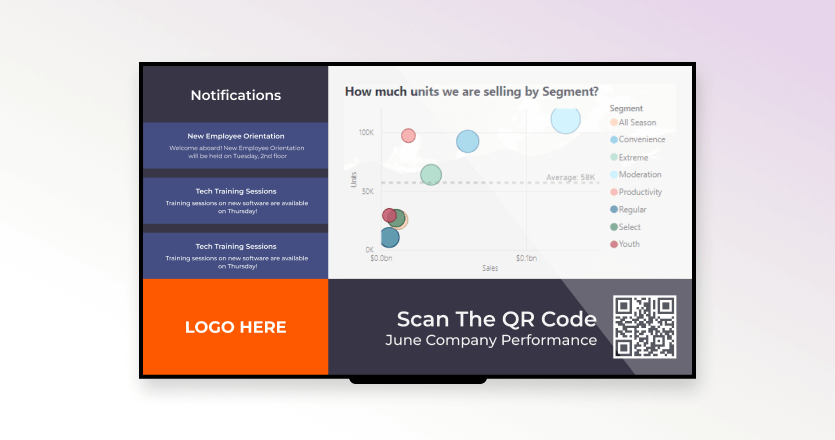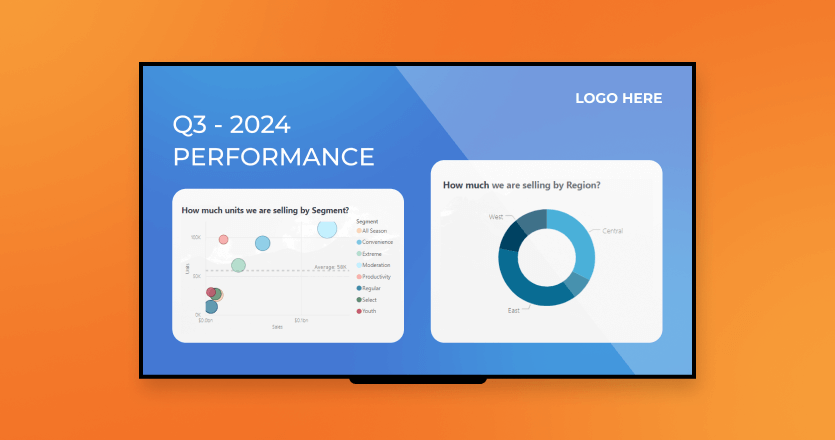If you work in a data-driven business, you are constantly thinking about how to make the best decisions quickly, and your major goal is to stay ahead of the competition. Decisions that will push the company to success. Data analytics dashboards are a tried-and-true approach for keeping your team on track and focused on the proper goals. However, because they have been in our lives for so long, they become monotonous and often difficult to understand. Here’s where business intelligence dashboards come in! A tool that efficiently converts complex key metrics into easy, meaningful insights. This article will go deeply into the field of business intelligence dashboards, answering essential questions related to what they do and their benefits and leading you toward reaching your full potential.
Bring business dashboards together with digital signage and boost the success of your team.
What is a business intelligence (BI) dashboard?
A business intelligence (BI) dashboard is a data visualization tool that gathers, through numerous sources, key performance indicators (KPIs) , metrics, and other vital company information and displays it on a screen. You can think of it as a visually appealing display that highlights the key metrics at a glance. Therefore, it allows you to quickly identify patterns, detect abnormalities, and make informed decisions.
What is the purpose of analytical dashboards in business intelligence?
The main purpose of a dashboard in business intelligence is to assist in data-driven decision-making by providing real-time valuable insights into many areas of business performance. These strategic dashboards collect data from several sources, including databases, spreadsheets, and cloud services, and present it in a visually appealing, comprehensible way.
BI dashboard versus BI report
While both BI dashboards and reports aim to provide insights, they differ in two major aspects: appearance and interactivity. Reports are often static documents that provide in-depth analysis, whereas business intelligence dashboards offer dynamic data visualization with real-time updates. This allows users to interact with the data and adjust views to their preferences.
What are the benefits of business intelligence dashboards?
The benefits of a digital business intelligence bi dashboard are numerous, and they enable organizations to:
- Gain real-time visibility into key metrics and performance indicators
- Identify trends, patterns, and abnormalities quickly
- Make data-driven decisions promptly
- Improve operational efficiency and productivity
- Enhance collaboration and communication across teams
- Track progress towards goals and objectives
- Identify areas for optimization and improvement
- Respond promptly to changing market conditions and business needs
How can business intelligence dashboards help you make business decisions?
In a few words, business intelligence dashboards will provide your company and team with valuable insights that will enable you to make informed decisions in a wide range of areas, such as marketing, sales, finance, operations, and human resources. Moreover, this extremely helpful bi tool manages resources effectively, avoids risks, and concentrates on market possibilities.

How can I create a business intelligence dashboard?
Creating a business intelligence dashboard involves some steps:
- Define objectives and KPIs: Determine the key metrics and performance indicators that are critical to your organization’s goals.
- Identify data source: Gather information from internal systems, external sources, and third-party apps.
- Clean up and prepare the data: Ensure data accuracy, consistency, and relevance by cleaning and modifying it as required.
- Select a dashboard tool: Choose business intelligence dashboard software that meets your needs for capability, scalability, and usability.
- Design the analytical dashboard: Create an attractive and user-friendly dashboard design that effectively communicates insights and simplifies decision-making.
- Test and iterate: Validate the dashboard design and functionality through testing and request feedback from stakeholders to ensure ongoing improvement.
Challenges in building business intelligence dashboards
Despite their many advantages, creating business intelligence bi dashboards can pose several difficulties, including:
Data quality issues: Inaccurate, incomplete, or inconsistent data may undermine the usefulness of the dashboard.
Integration complexities: Combining data from several sources and systems can be difficult and time-consuming.
User adoption: Ensure that the KPI dashboard meets the demands of its intended users and is simple to use. This is critical for increasing adoption and optimizing its impact.
Security concerns: Protecting sensitive data and ensuring compliance with data privacy regulations is extremely important.
Performance optimization: Optimizing dashboard performance to handle massive amounts of data and provide real-time updates can be challenging.
BI dashboard design best practices
BI dashboard software
There is a plethora of business information dashboard software on the market that caters to many different kinds of needs and budgets. Some popular options are:
- Tableau
- Microsoft Power BI
- Zoho Analytics
- QlikView
- Domo
- Sisense
- Google Data Studio
These tools cover plenty of functions, including data visualization, dashboard creation, data integration, and collaboration capabilities, allowing enterprises to maximize the potential of their data and achieve better business outcomes.
Yodeck has everything
Yodeck is an affordable option for integrating BI dashboards into your business operations. Yodeck’s Digital Signage TV Dashboard not only optimizes efficiency and improves office management, but it also dynamically visualizes mission-critical data and analytics in real-time. Yodeck’s versatile templates and user-friendly apps make it effortless to successfully display BI dashboards, increasing staff productivity, promoting collaboration, and meeting key performance indicators.

Thus, to summarize, business intelligence dashboards are essential tools for modern businesses looking to establish a competitive advantage through data-driven insights. By giving real-time access to critical metrics, trends, and performance indicators, these operational dashboards enable decision-makers to make well-informed decisions, optimize operations, and effectively achieve their strategic objectives. With the right approach and tools, businesses can harness the power of business intelligence dashboards to drive innovation, growth, and success in today’s changing business environment.
